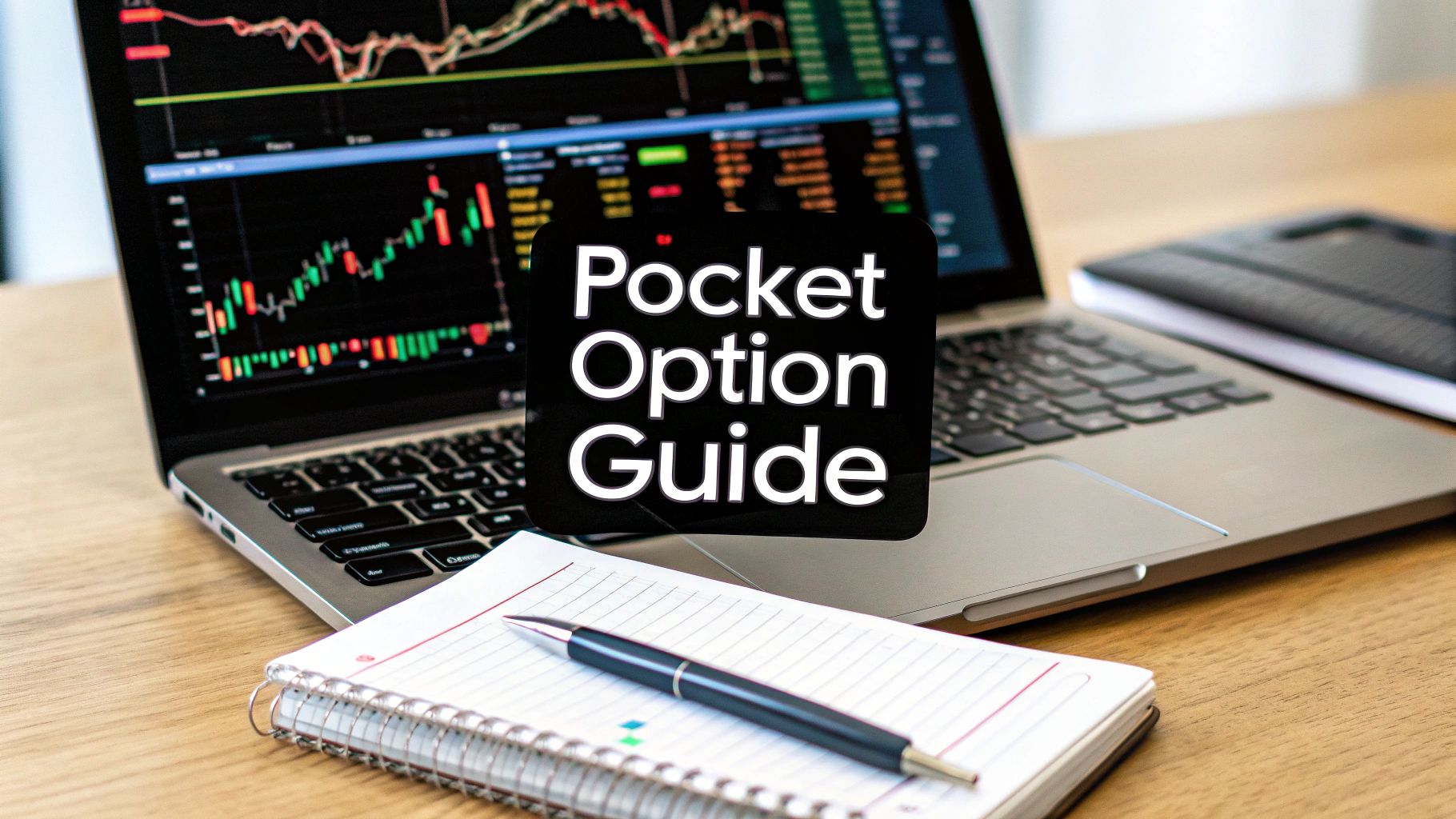Diving into the world of online trading can feel like a huge leap, but platforms like Pocket Option are genuinely built to soften the landing. I've seen many new traders get overwhelmed, but the way Pocket Option is structured really helps bridge that initial gap. It combines a low barrier to entry with some surprisingly powerful tools, making pocket option trading for beginners a lot less daunting than it might seem.
Let's walk through how to get started without that feeling of being in over your head.
Getting Started Without Getting Overwhelmed
From my experience, the biggest roadblock for new traders isn't the complexity of the market—it's building the confidence to place that first trade. Pocket Option tackles this head-on. Its interface is clean and intuitive, designed to ease you into binary options trading instead of burying you in jargon. The platform focuses on presenting information visually, which helps you get a feel for market movements much more naturally.
Core Concepts in Plain English
At its core, trading on Pocket Option boils down to a simple prediction: will an asset's price go up or down from its current level within a specific timeframe? That's the essence of binary options. You aren't buying and holding gold bars or company stock; you're simply speculating on the short-term direction of the price.
Here's a practical example: You're looking at the price of gold and your analysis suggests it will rise in the next five minutes. You'd place a "Higher" trade. If you're right when the time is up, you collect a fixed, predetermined profit. It’s this straightforwardness that makes it such a popular starting point.
When you first log in, the main screen lays everything out for you—the live price chart is front and center, with all your trading controls neatly organized on the right.
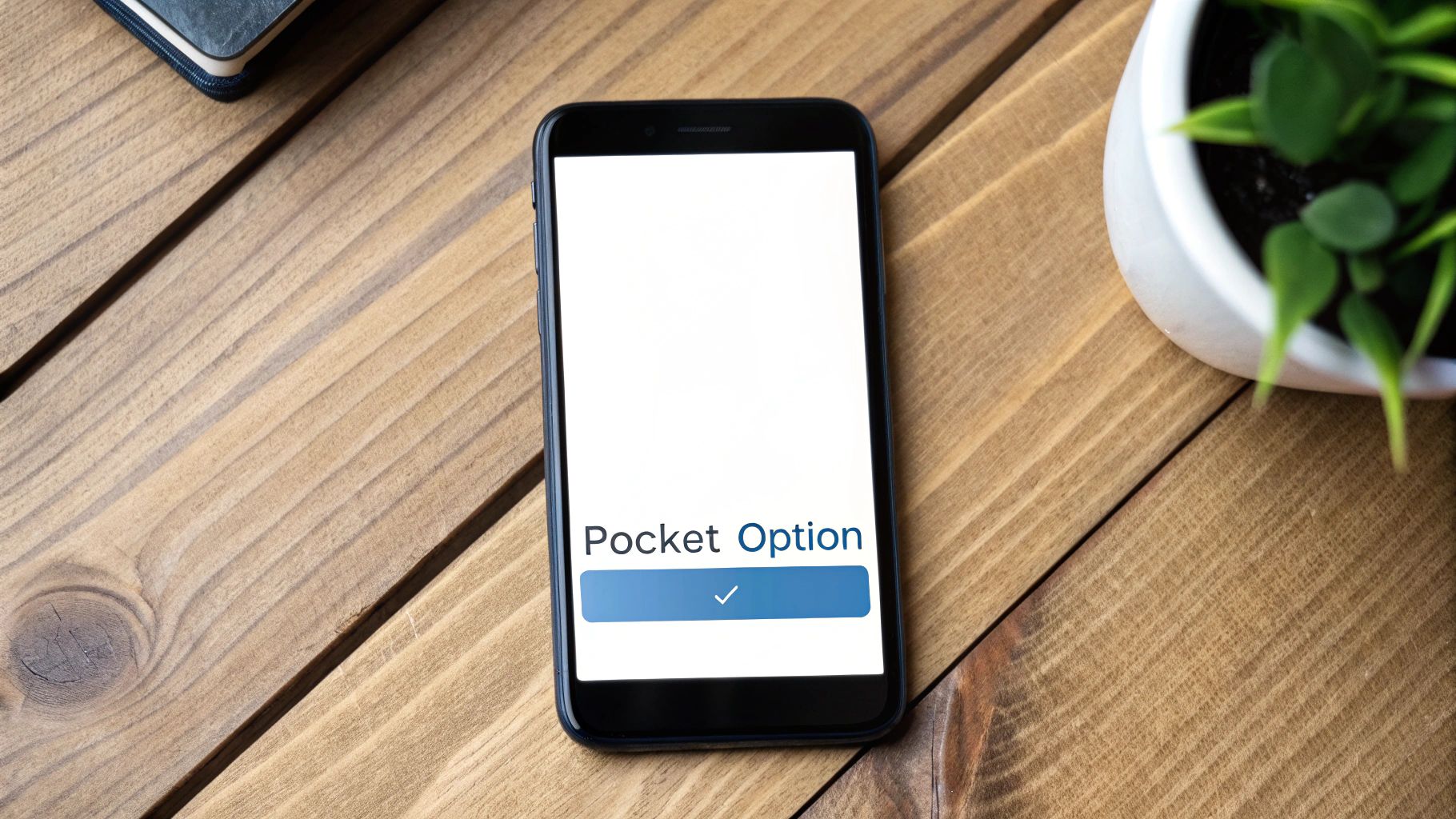
This setup means you can see the asset's movement and execute a trade without having to click through multiple windows, which is a huge plus when timing is everything.
To help you get acquainted, here's a quick look at some of the features that make the platform so accessible for newcomers.
Pocket Option Core Features for New Traders
| Feature | Benefit for Beginners |
|---|---|
| $1 Minimum Trade | Allows you to start with very low risk, making it easier to learn without a large financial commitment. |
| Free Demo Account | A $10,000 virtual balance lets you practice strategies and get comfortable with the interface risk-free. |
| User-Friendly Interface | The clean layout with a central chart and clear controls reduces the initial learning curve. |
| Over 20 Technical Indicators | Access to essential tools like Moving Averages and RSI helps you start analyzing charts from day one. |
| AI Mode & Copy Trading | These features offer a way to learn from automated signals or experienced traders, shortening the path to informed trading. |
These core features are what make Pocket Option a solid choice for those just starting out. You can learn more about these beginner-friendly platform features on Tradingfinder.com.
Demo vs. Live: The Critical Difference
Pocket Option gives you two distinct trading environments: a free demo account and a live account. Think of the demo account as your personal trading gym. It's a completely risk-free space to test-drive strategies, learn the platform inside and out, and make all your beginner mistakes without losing a single dollar.
The single best piece of advice I can give is to treat the demo account like it's real money. Develop and stick to a trading plan there first. This builds the discipline and habits you'll absolutely need for long-term success.
Once you’ve built some confidence and found an approach that works for you consistently in the demo, you can make the switch to a live account. This is where your own capital is on the line, and it’s where the real psychology of trading kicks in. The platform makes the transition seamless, but don't underestimate the emotional shift. That's precisely why spending quality time in the demo account is not just recommended—it's essential.
Getting Your Account Set Up and Navigating the Platform
Alright, let's get you in the door and comfortable with the Pocket Option platform. The sign-up process is refreshingly simple because they want you to get to the action, not get stuck filling out endless forms. Think of this first step not just as creating a login, but as building your personal trading command center.
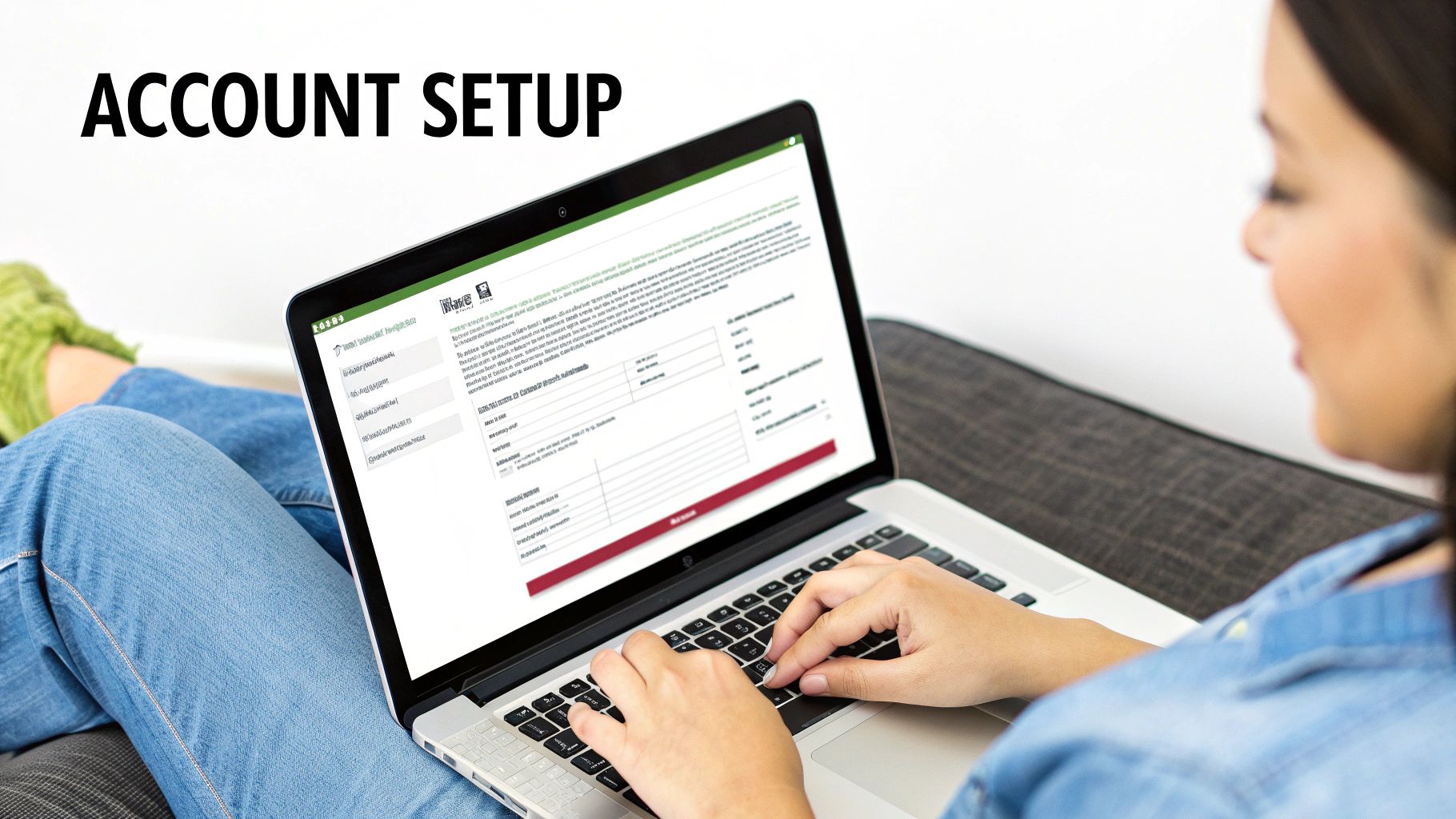
First, you'll just need a valid email and a strong password. After you click the confirmation link in your email, you're in. The platform immediately drops you into a $10,000 demo account, and my advice is to live there for a while. Seriously, spend your first few hours just clicking on everything. Get a real feel for the layout before you even consider trading with real money.
A quick but important bit of housekeeping: complete the identity verification process right away. This is a standard security check for any reputable broker and is absolutely necessary before you can withdraw any winnings. It’s a simple upload of a government ID and proof of address. Getting it out of the way now saves you from headaches and delays later.
Finding Your Way Around the Trading Dashboard
When you first log in, the dashboard can look like a lot to take in. Don't worry, it's actually laid out quite intuitively. Your focus will almost always be on three key zones. If you're serious about pocket option trading for beginners, mastering this layout is your first real task.
- The Asset Menu: Tucked in the top left, this is your marketplace. Here you’ll pick what you want to trade—from major currency pairs like EUR/USD to stocks, crypto, and commodities.
- The Main Chart: This is the heart of the platform. It takes up most of the screen for a reason, showing you the live price action of the asset you've selected.
- The Trade Panel: Over on the right, this is your control panel. You’ll set your investment amount, choose an expiration time, and then make your call: "Higher" or "Lower."
One of the best features is how easily you can flip between your demo and live accounts. It’s just one click. This is perfect for when you have a new strategy idea—you can test it out in the demo without risking a dime and then apply it with real funds if it works.
From personal experience, the single biggest thing that separates successful new traders from those who fail is how they use the demo account. Treat that virtual $10,000 like it’s your own. The discipline you build here is what will protect your real capital down the road.
Making the Workspace Your Own
The default chart is a blank canvas. To trade effectively, you need to add your tools—the technical indicators that help you make sense of the market's chaos. Pocket Option has more than 20 built-in, but you don't need to learn them all at once.
Start simple. A fantastic combination for anyone new to trading is a Moving Average to see the general trend direction and the Relative Strength Index (RSI) to identify when an asset might be overbought or oversold.
Let's walk through adding your first one.
How to Add an Indicator (Example)
- Look for the "Indicators" icon on your chart; it usually looks like a little compass or graph.
- A list will pop up. Find and select "Moving Average."
- For now, just stick with the default settings (a period of 10 is common) and hit "Apply."
- Instantly, you'll see a new line drawn over the price on your chart, smoothing out the frantic movements and making the trend clearer.
Just like that, you've transformed a basic chart into a genuine analysis tool. This is why spending time in the demo is so critical. It’s your sandbox for experimenting with these indicators, letting you build both skill and confidence before you put real money on the line.
Placing Your First Trades: A Practical Walkthrough
Theory only gets you so far. Real confidence comes from doing, so let's jump in and make your first few trades in the risk-free demo account. The point here isn't to rack up a virtual fortune; it's about getting comfortable with the platform and building some muscle memory.
We'll use a classic for this walkthrough: the EUR/USD currency pair. It's a favorite for newcomers because it's always moving and has plenty of trading volume, which makes for a great learning environment.
Executing a Simple Trade
First, find and select EUR/USD from the asset list at the top. Now, glance over to the trading panel on the right side of your screen. You'll see a field for the "Trade Amount." Let's keep it simple and type in $1. This is exactly why the demo account is so valuable—you can learn the mechanics without risking any real money.
Next up is the "Purchase Time," which is just another way of saying the trade's expiration. For your first go, pick a short timeframe like M1 (one minute). This gives you quick feedback and lets you repeat the process a few times to really get the hang of it.
Now for the big decision: will the price be higher or lower than it is right now when that minute is up?
Take a look at the chart. Is the price generally creeping up, or is it sliding down? Don't get stuck on analysis just yet. For this exercise, a simple visual guess is perfect. If you think it's going up, click the green "Higher" button. If it looks like it's heading down, hit the red "Lower" button.
This image breaks down the core steps into a simple visual flow.
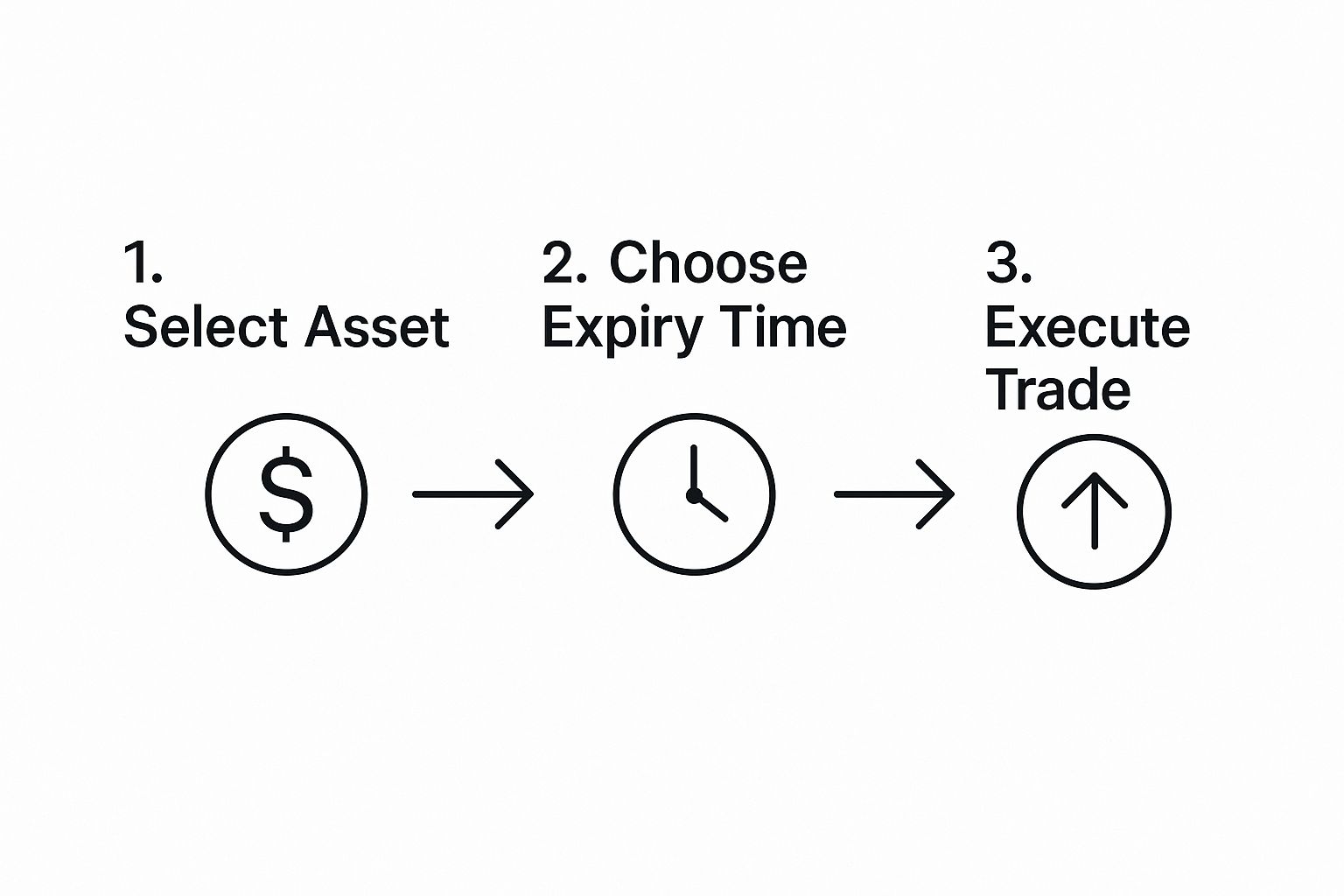
From picking your asset to making the call, this shows just how straightforward the process can be.
The moment you click, your trade is live. You can see it in your "Open Positions" tab, complete with a countdown timer. Watching that timer tick down is your first real taste of monitoring a trade in real-time. As you get more comfortable, you’ll want to learn more about what the chart movements mean. Our guide on how to read binary options charts is a great next step for that.
Introducing Foundational Risk Management
It's never too early to build good habits, even in a demo account. Pocket Option has tools like Take Profit and Stop Loss, which are absolutely critical for protecting your account when you start trading for real.
- Take Profit: An order that automatically closes a winning trade once it hits a specific profit target, even before the timer runs out.
- Stop Loss: An order that automatically closes a losing trade if it moves against you by a pre-set amount, capping your potential loss.
While these tools are often associated with other trading styles, just knowing what they are from day one is a huge advantage. For now, though, just keep placing those small $1 trades. Get a feel for the rhythm of the platform, the look of a winning trade, and the sting of a losing one.
Don't sweat the losses in your demo account. Seriously. Every loss is just data. It’s a chance to figure out what happened without any real-world consequences.
The whole point of this walkthrough is to make the mechanics of placing a trade second nature. Keep repeating the process until you can pick an asset, set the amount, and place a trade without having to think about it. This is the foundation you'll build all of your future strategies on.
Building a Simple and Effective Trading Strategy
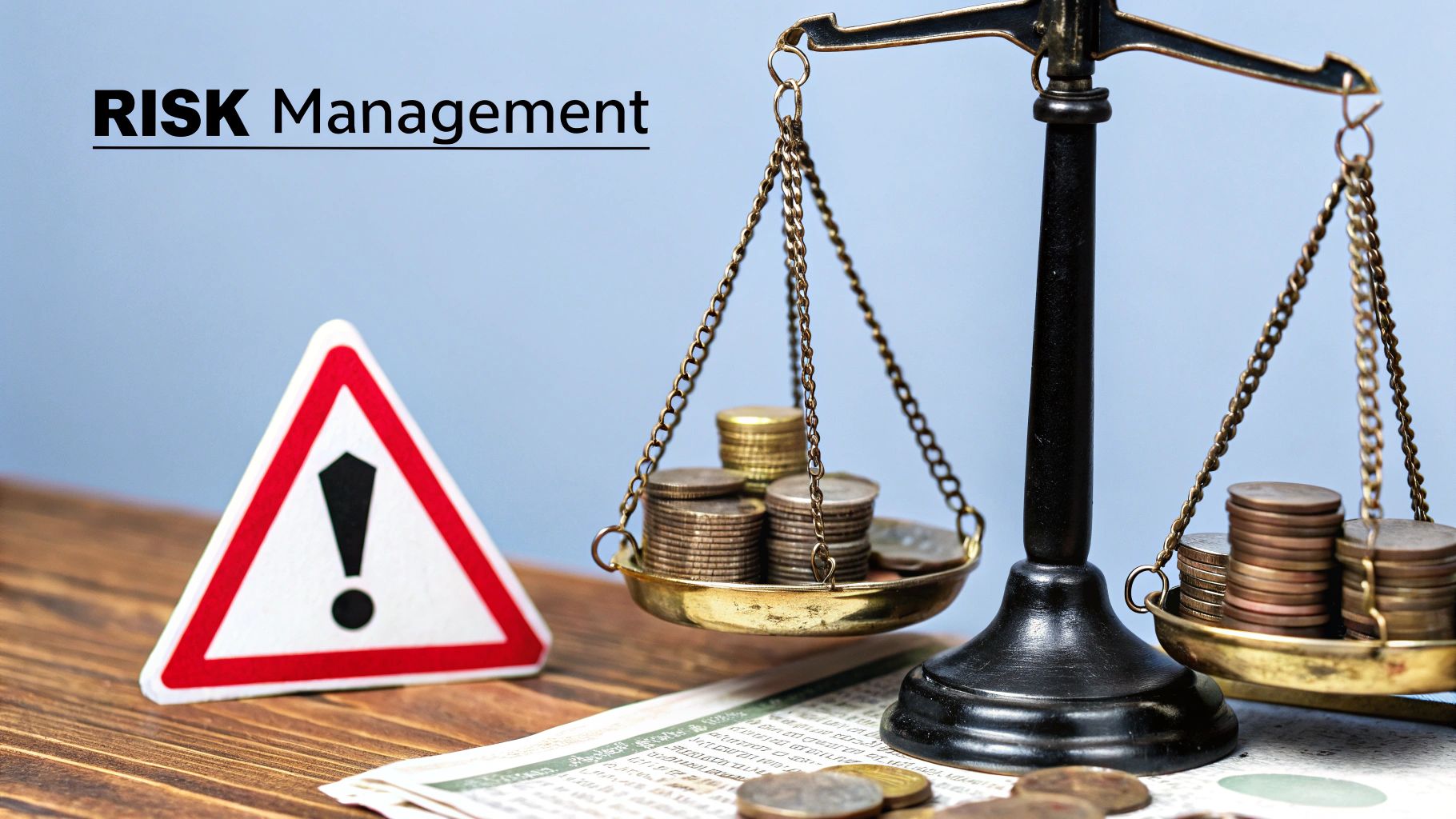
If you're just randomly mashing the 'Higher' or 'Lower' buttons, you're not trading—you're gambling. Real success in the markets, especially with pocket option trading for beginners, comes from having a solid plan. A good strategy is your roadmap, telling you when to enter a trade and, just as crucially, when to keep your money on the sidelines.
Don't fall into the trap of thinking a strategy needs to be complicated. When you're just starting, the opposite is true. Simpler is almost always better. It's all about making decisions based on what the chart tells you, not what your gut feels.
Combining Basic Indicators for Clear Signals
The best way to build a reliable beginner strategy is by combining two or three basic technical indicators. Let's start with a couple of classics you'll find on the Pocket Option platform: Moving Averages and the Relative Strength Index (RSI).
-
Moving Averages (MA): Think of these as a way to smooth out the chaotic price movements to see the real, underlying trend. A very common and effective technique is using two MAs: a fast one (like a 9-period) and a slow one (like a 21-period). When the fast line crosses above the slow one, it's often a signal that an uptrend is forming (a potential "buy"). When it crosses below, it can signal a downtrend is starting (a potential "sell").
-
Relative Strength Index (RSI): This indicator acts like a speedometer for the market, measuring the speed and change of price on a scale from 0 to 100. It’s fantastic for spotting "overbought" (usually above 70) or "oversold" (usually below 30) conditions. An overbought asset is stretched too thin and might be due for a pullback, while an oversold one might be ready to bounce back.
Now, let's put it all together. A simple, powerful rule could be: you only look for a 'Higher' trade when the fast MA crosses above the slow MA and the RSI is not in the overbought zone. This combination gives you a much higher-probability signal than using either indicator on its own. For a deeper dive into this exact setup, check out our guide on building a simple trading system.
The Power of Discipline Over Intuition
Having a set of rules is the easy part. The real test? Sticking to them. Your biggest enemy will be the urge to break your rules because of fear or greed. A disciplined trader will always, always beat an impulsive one in the long run.
Key Takeaway: When the market gets choppy, trading on gut feelings can fail upwards of 63% of the time. A disciplined, data-driven strategy is your best shield against emotional mistakes.
The data doesn't lie. Traders who switch to a quantitative approach often see a remarkable turnaround. We've seen traders restore their accounts to achieve win rates as high as 72% with a solid reward-to-risk ratio of 2.1, all by trusting statistical signals. The secret is to have faith in your system, even when you hit a few losses. No strategy wins every time, but consistency is what creates profit.
Using Advanced Tools to Sharpen Your Edge
When you're comfortable with the basics, it's time to start exploring the tools that give seasoned traders their edge. Pocket Option packs some powerful features that might seem advanced at first, but they're surprisingly accessible once you know how to approach them. This is where you graduate from simply placing trades to making strategic, data-driven decisions.
The goal isn't to overcomplicate things. It's about using technology to make your trading more consistent. Think of these tools as a way to spot opportunities your own eyes might miss or to manage risk with much greater precision. This is a huge step in moving forward in your pocket option trading for beginners journey.
https://www.youtube.com/embed/BUCPPCXOHbs
Learning from the Pros with Social Trading
One of the platform's most powerful features is social trading, which you might also hear called copy trading. It gives you a real-time window into the trades of the most successful users on the platform. Even better, you can set your account to automatically mirror their trades.
Imagine being able to follow a trader with a proven, profitable track record. When they make a move, your account makes the same one, but scaled to an amount you're comfortable with. It's a fantastic way to learn by watching successful strategies unfold in a live environment. The key, however, is to not just copy blindly. Use it as a learning opportunity to figure out why they're making the moves they are.
Decoding the Market with AI and Indicators
Pocket Option also offers AI-powered signals that are built to flag potential trading opportunities based on market analysis. These can be a great second opinion, either confirming what you already see or pointing out a setup you might have otherwise missed.
But to really sharpen your instincts, you need to go beyond basic signals and build smarter risk management habits. This is where more advanced indicators, like the Average True Range (ATR), become invaluable.
The ATR indicator is a game-changer because it measures market volatility. Instead of guessing or using the same trade size for every position, ATR lets you adjust your size based on current conditions—risking less when the market is chaotic and potentially more when things are calm.
This disciplined approach to risk is what separates hobbyists from serious traders. In fact, traders who use dynamic position sizing based on volatility often experience significantly smaller drawdowns.
Many advanced traders also rely on building strategies that require a triple confirmation—for example, combining signals from moving averages, the RSI, and the MACD. This simple filtering technique can boost the accuracy of your trade signals up to 75%. To learn more about how this works in practice, you can find a deep dive into how these strategies deliver profitable results on the Pocket Option blog. This method helps you weed out weak signals and focus only on the setups with the highest probability of success.
The table below breaks down how these tools serve different purposes as you grow from a beginner to a more advanced trader.
Beginner vs Advanced Tool Comparison
| Tool/Feature | Beginner Application | Advanced Benefit |
|---|---|---|
| Social Trading | Following and copying top traders to learn the ropes and earn passively. | Analyzing multiple top traders to identify broader market sentiment or strategy trends. |
| AI Signals | Using alerts as a primary reason to consider a trade. | Using alerts as a confirmation tool to validate one's own analysis. |
| Indicators (RSI, MACD) | Using a single indicator to get a "buy" or "sell" signal. | Combining multiple indicators (triple confirmation) for higher-probability setups. |
| Average True Range (ATR) | Not typically used by beginners; risk is often a fixed dollar amount. | Dynamically adjusting trade size based on market volatility to optimize risk management. |
As you can see, the tools don't change, but how you use them evolves. What starts as a simple guide can become a sophisticated instrument for making nuanced market decisions.
Common Questions from New Traders
Jumping into trading for the first time? It's completely normal to have a ton of questions. As you get started with pocket option trading for beginners, tackling these common concerns right away is the smart move. Getting straight answers builds the confidence you need to start trading effectively and, more importantly, safely. Let's dig into what new traders ask most often.
Is Pocket Option Safe for Beginners?
The short answer is yes, Pocket Option is generally considered a safe starting point. A big reason for this is just how accessible the platform is. It's regulated by the Mwali International Services Authority (MISA), which gives it a basic framework of oversight. Features like a low minimum deposit and a generous $10,000 demo account are clearly there to help newcomers get their feet wet without a huge upfront risk.
But here’s the thing: safety in trading is a shared responsibility. The platform gives you the tools, but your security really comes down to how you use them. That means spending serious time on the demo account, never trading with money you can't afford to lose, and making education a priority.
The single most important thing for your safety is disciplined risk management, starting from your very first trade. It's what separates learning from a small mistake from suffering a big, discouraging loss.
Building good habits from day one isn't optional if you want to stick around. A great place to start is by understanding some foundational trading risk management techniques that will serve you no matter what market you trade.
How Much Money Do I Need to Start Trading?
This is where Pocket Option really shines for anyone just starting out. While you can often get started with a deposit as low as $50, the number that really matters is the minimum trade size: just $1.
This incredibly low entry point makes for a smooth, low-stress transition from your demo account to live trading. You can start using real money, but the stakes are so small that the emotional pressure is almost non-existent. It’s the perfect way to learn how to handle the psychology of having actual cash on the line.
Can You Actually Make Money on Pocket Option?
Absolutely. It is entirely possible to be profitable on Pocket Option, and the platform offers high payouts on winning trades. However, it's just as easy to lose money, especially if you jump in without a plan and let your emotions drive your decisions.
Sustainable profit isn't about getting lucky. It comes down to three key things:
- A Disciplined Strategy: You need clear, pre-set rules for when you enter and exit a trade. No exceptions.
- Solid Risk Management: Know exactly how much you're willing to risk per trade and per day before you even open the platform.
- Emotional Control: You must stick to your plan, even when fear or greed is screaming at you to do something else.
So many traders fail because they try to skip this foundational work. You earn your profits in the demo account long before you ever see them with real money.
Ready to elevate your trading analysis with professional-grade tools? OTC Charts MT4 provides precise, real-time OTC data directly within your MT4 interface, giving you the edge you need to make more informed decisions.
Get Started with OTC Charts MT4 Today


